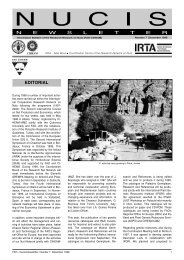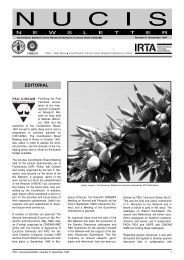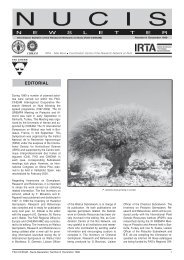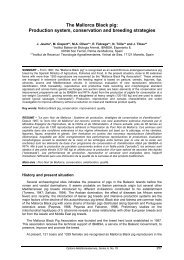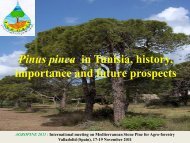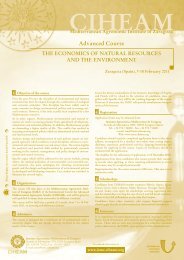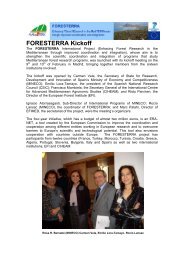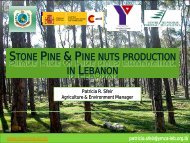NUCIS number 12. September 2004. 52 pages (full ... - IAMZ - ciheam
NUCIS number 12. September 2004. 52 pages (full ... - IAMZ - ciheam
NUCIS number 12. September 2004. 52 pages (full ... - IAMZ - ciheam
- No tags were found...
Create successful ePaper yourself
Turn your PDF publications into a flip-book with our unique Google optimized e-Paper software.
Bliss F.A., Arulsekar S., Foolad M.R.,Becerra V., Gillen A., Warburton M.L.,Dandekar A.M., Kocsine G.M. and K.K.Mydin. 2002. An expanded geneticlinkage map of Prunus based on an interspecificcross between almond andpeach. Genome 45: <strong>52</strong>0-<strong>52</strong>9.Bošković R., Tobutt K.R., Batlle I. andH. Duval. 1997. Correlation of ribonucleasezymograms and incompatibilitygenotypes in almond. Euphytica 97:167-176.Bošković R. , Tobutt K R, Batlle I., Duval.H, Martínez-Gómez P. and T.M.Gradziel. 2003. Stylar ribonucleases inalmond: correlation with and predictionof self-incompatibility genotypes. PlantBreed. 122: 70-76.Cerezo M., Socias i Company R. and P.Arús. 1989. Identification of almond cultivarsby pollen isoenzymes. J. Am.Soc. Hort. Sci. 114: 164-169.Channuntapipat C., Wirthensohn M.,Ramesh S.A., Batlle I., Arús P., SedgleyM. and G. Collins. 2003. Identification ofincompatibility genotypes in almondusing specific primers based on the intronsof the S-alleles. Plant Breed. 122:164-168.Dicenta F. and J.E. García. 1993. Inheritanceof self-compatibility in almond.Heredity 70: 313-317.Gradziel T.M., Martínez-Gómez P., DicentaF., and D.E. Kester. 2001a. Theutilization of related almond species foralmond variety improvement. J. Am.Pomolog. Soc. 55: 100-109.Gradziel T.M., Martínez-Gómez P. andA.M. Dandekar. 2001b. The use of S-allele specific PCR analysis to improvebreeding efficiency for self-fertility in almond.HortScience 36: 440-440.Hauagge R., Kester D.E. and R.A.Asay. 1987. Isozyme variation amongCalifornia almond cultivars: I. Inheritance.J. Am. Soc. Hort. Sci. 112: 687-693.Jáuregui B., de Vicente M.C., MesseguerR., Felipe A., Bonnet A., SalessesG. and P. Arús. 2001. A reciprocaltranslocation between ‘Garfi’ almondand ‘Nemared’ peach. Theor. Appl. Genet.102: 1169-1176.Joobeur T., Viruel M.A., de VicenteM.C., Jáuregui B., Ballester J., DettoriM.T., Verde I., Truco M.J., MesseguerR., Battle I., Quarta R., Dirlewanger E.,and P. Arús. 1998. Construction of asaturated linkage map for Prunus usingan almond x peach F 2progeny. Theor.Appl. Genet. 97: 1034-1041.Joobeur T., Periam N., de Vicente M.C.,King G.J. and P. Arús. 2000. Developmentof a second generation linkagemap for almond using RAPD and SSRmarkers. Genome 43: 649-655.Kester D.E. and T.M. Gradziel. 1996.Almonds (Prunus). In: Moore, J.N. andJanick, J. (eds.). Fruit Breeding. NewYork: Wiley. p. 1-97.Martínez-Gómez P. and T.M. Gradziel.2003. Sexual polyembryony in almond.Sex. Plant Reprod. 16: 135-139.Martínez-Gómez P., Arulsekar S., PotterD., T.M. and Gradziel T.M. 2003a.An extended interspecific gene poolavailable to peach and almond breedingas characterized using simple sequencerepeat (SSR) markers. Euphytica 131:313-322.Martínez-Gómez P., Arulsekar S., PotterD., and T.M. Gradziel. 2003b. Relationshipsamong peach and almond andrelated species as detected by SSRmarkers. J. Amer. Soc. Hort. Sci. 128:667-671.Martins M., Tenreiro R. and M.M. Oliveira.2003. Genetic relatedness of Portuguesealmond cultivars assessed byRAPD and ISSR markers. Plant CellRep. 22: 71-78.Ortega E. and F. Dicenta. 2003. Inheritanceof self-compatibility in almond:breeding strategies to assure self-compatibilityin the progeny. Theor. Appl.Genet. 106: 904-911.Powell W., Morgante M., Andre C., HanafeyM., Vogel J., Tingey S., and A.Rafalski. 1996. Comparison of RFLP,RAPD, AFLP and SSR (microsatellite)markers for germplasm analysis. Mol.Breed. 2: 225-238.Sathe S.K., Teuber S.S., Gradziel T.M.,and K.H. Roux. 2001. Electrophoreticand immunological analyses of almond(Prunus dulcis L.) genotypes and hybrids.J. Agr. Food Chem. 49: 2043-20<strong>52</strong>.Tamura M., Ushijima K., Sassa H., HiranoH., Tao R., Gradziel T.M. and A.M.Dandekar. 2000. Identification of selfincompatibilitygenotypes of almond byallele-specific PCR analysis. Theor.Appl. Genet. 101: 344-349.Viruel M.A., Messeguer R., de VicenteM.C., Garcia-Mas J., Puigdomènech P.,Vargas F. and P. Arús. 1995. A linkagemap with RFLP and isozyme markersfor almond. Theor. Appl. Genet. 91:964-971.Wünsch A. and J.I. Hormaza. 2002.Cultivar identification and genetic fingerprintingof temperate fruit tree speciesusing DNA markers. Euphytica125: 56-67.1R. Sánchez-Pérez, 1 F. Dicenta, 2 T.M.Gradziel, 3 P. Arús, and 1 P. Martínez-Gómez.1CEBAS-CSIC. Departamento de Mejoray Patología Vegetal, Apdo 4195, 30.080,Murcia, Spain.2University of California-Davis,Dept. of Pomology, Davis,CA-95616, USA.3IRTA. Departament de Genètica Vegetal.Crta. Cabrils s/n, E-08348 Cabrils,Barcelona, Spain.E-mail: pmartinez@cebas.csic.esFusicoccum CANKERIN ALMOND ORCHARDS –BIOTECHNOLOGY TOOLSFOR EARLY SELECTIONOF TOLERANT GENOTYPESFusicoccum CANKER ON ALMONDAlmond is an important crop in the Mediterraneanregion, reaching about 28% ofthe world production. However, its susceptibility,particularly to certain fungal diseasessuch as brown rot blossom blight,constriction canker and almond scab,which can cause severe damage on foliageand branches of the tree, can be a majorimpediment for almond production.Regarding Fusicoccum canker or constrictioncanker, this is a damaging andeconomically important fungal disease inalmond orchards in the Mediterranean region,caused by Phomopsis amygdali(Del.) (perfect stage) Tuset and Portilla,formerly classified as Fusicoccum amygdaliDelacr. (imperfect stage). Besides almond,this fungus also infects peachtrees. Symptoms of this disease usuallyappear in early summer and become increasinglyevident as more infectedshoots appear through late summer. In almondmainly two types of symptoms arevisible, on shoots and on May spurs. Infectedtwigs and shoots wilt, and eventuallydie, because of elongate, brown,sunken cankers, often with a well delimitedoval pattern (Grasselly and Duval,1997) (Fig. 1).The group of leaves that form May spurswilt due to the infection, caused on thatspring or on the previous autumn. It isalso possible to observe cankers on theinternodes of these spurs. Leaves in generalcan also be affected, showing necrosisthat usually appear as big brownspots with circular or irregular shape.Gumming is commonly associated withthe cankers, although it is not a gooddiagnostic characteristic since otheragents may also be responsible for thissign. Constrictions formed at the base ofinfected shoots and leaf symptoms producedwell beyond the infection site resultfrom a translocatable toxin, fusicoccin, aphytotoxic terpenoid glucoside. Fusicoccin,increases the influx of potassium onguard cells inducing the permanent openingof the stomata and the consequenthigh loss of water can eventually lead toplant death (De Boer, 1997).The development of Fusicoccum cankeris favoured by high nitrogen levels in thesoil and by wet weather, since this diseaseis transmitted by rain (Rosenberg,1996). Most infections occur during12 FAO-CIHEAM - Nucis-Newsletter, Number 12 <strong>September</strong> 2004



